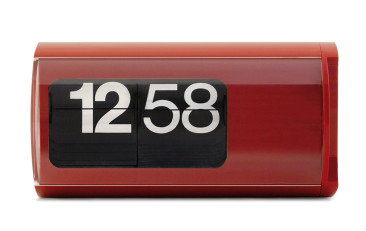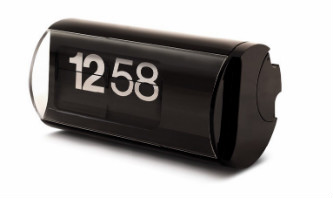History of the Solari Cifra 3
Collapse
History of the Solari Udine Cifra 3 - The World's Most Renowned Flip Clock
~ by Mackey Hensley, Administrator of Flip Clock Fans
 To many in the United States interested in vintage flip clocks, the name Solari Udine and Cifra 3 can often be shrouded in mystery and some hyperbole. Many have taken to calling the Cifra 3 the "Holy Grail of Flip Clocks." While this title may be just a little exaggerated, the clock that started the flip clock explosion in the US (primarily in the 1970s and early 80s), and around the world, was none other than, the Solari Udine Cifra 3. Today, as interest in flip clocks resurges (as vintage or retro design pieces), and as modern companies such as Twemco, Fartech, OEM, and Solari Udine, and other Chinese companies now produce new flip clocks, the Solari Cifra 3 remains at the pinnacle of design for these functional and elegant retro time pieces.
To many in the United States interested in vintage flip clocks, the name Solari Udine and Cifra 3 can often be shrouded in mystery and some hyperbole. Many have taken to calling the Cifra 3 the "Holy Grail of Flip Clocks." While this title may be just a little exaggerated, the clock that started the flip clock explosion in the US (primarily in the 1970s and early 80s), and around the world, was none other than, the Solari Udine Cifra 3. Today, as interest in flip clocks resurges (as vintage or retro design pieces), and as modern companies such as Twemco, Fartech, OEM, and Solari Udine, and other Chinese companies now produce new flip clocks, the Solari Cifra 3 remains at the pinnacle of design for these functional and elegant retro time pieces.Typically referred to as a "flap clock" outside of the United States, The Italian made Solari Cifra 3 was first produced in 1966 with significant world-wide sales into the 1970s.
The clock was Re-issued in 1993 and came to be know as "The Museum Clock" by collectors - identified by the Museum of Modern Art Serial number and released at the Museum of Modern Art, New York.
Most recently, the Cifra 3, under the Solari lineadesign brand, was reintroduced to the world April 2015 in Milan, Italy.
At this time, the clock is most sought after and collected in Italy, where it seems to be a source of national pride. Some collectors seem to look down upon, "The Museum Clock" of 1993, possibly due to it's connection to the American Museum of Modern Art or the fact that the clock was produced during a time of great financial strain on the company. In any event, all editions of the clocks are hard to come by, especially in the United States (They rarely come up for auction on internet auction sites in the US). Unfortunately for flip clock fanatics, the new reproduction of the Cifra 3 comes with a high price tag - $600.00 from the solari lineadesign website. However, on eBay the clock can be purchased starting at just over $450.00.
How to properly pronounce Solari Undine Cifra 3
To understand why these clocks are so important historically and why they remain so sought after by collectors worldwide, we must learn some history of Italian design and engineering.
The History of the Solari di Udine Company
Early Beginnings
In 1725 the Solari name was first established in clock business through the company Ditta Fratelli Solari "Antica e premiata fabbrica di orologi da torre" (The Solari Brothers Company "Antique and Awarded Tower Clock Factory"). The first manufacturing facility, established in Pesariis, Italy, fabricated a substantial portion of the bell tower clocks used throughout Italy.
Modern Italian Company
Solari di Udine, an offshoot of Ditta Fratelli Solari (Solari Brothers Company), was
 established by brothers, Fermo and Remigio Solari in Udine, Italy in 1948.
established by brothers, Fermo and Remigio Solari in Udine, Italy in 1948.It was there that Remigio Solari invented what would come to be called the Solari Board - the mechanical masterpiece that displayed numbers and letters on a rotating flap system. These information display systems have been seen the world over since the 1950s and 60s in train and airports displaying arrival and departure times. First installed at the Liège-Guillemins Railway Station, Liège, Belgium in 1956, Solari Boards remain active today in many places throughout the world.
Solari Boards produce a very distinctive sound when data is changed.
Creation of A Masterpiece
Inspired by the success of the split-flap display, the Solari Udine Cifra 3 Flap Clock was created in 1965.
Designed by the famed Italian architect and designer, Gino Valle, the clock received rave reviews upon it's release in 1966 for it's modernistic, elegant and functional design.
The Solari di Udine company received the Italian Compasso d'Oro (Golden Compass) industrial design award on the merits of its work with the split flap mechanisms that became the foundation for the Cifra 3 and other respected and prized clocks (the Cifra 5, Emera 5, Dator 5 and Dator 10 among others). Soon after it's release, the Solari Udine Cifra 3 became a part of the permanent "Humble Masterpieces" collection at the Museum of Modern Art (MoMA) in New York. The clock has also been recognized in the Science Museum collection in London and is featured in the permanent Triennale Design Museum collection in Milan, Italy.
Engineering Of A New Concept In Time Display
The Cifra 3 clock mechanism consists of a split flap display, first conceived by Remigio Solari and adapted under the direction of Fermo Solari, reportedly with engeneering assistance from the Belgian inventor, John Myer. A testament to this clock's superior engineering, the design of the Cifra 3 mechanism has remained unchanged since 1966. The clock measures 18 by 9.5 centimeters (approximately 7.1 by 3.7 inches). The split-flap mechanism consists of two wheels of plastic flaps with white numbers on a black background - one wheel consisting of with 48 flaps for the hours (using the 24 hour time system), and the other with 120 for the minutes. Each number is displayed by two separate flaps presented together (hence the name "split-flap"). The clock produces a clearly audible flap sound each minute, and a pronounced loud flap each hour, reminiscent of the sound of the train station Solari boards.
The Copying Of A Successful Time Device
The success of the Cifra 3 spurred many American and various international manufacturers to design and market their own version of the new "digital clock" in the 1970s These companies included General Electric, Copal, National Panasonic (Panasonic), Sankyo Seiki Mfg. Co, Hitachi, Ken-Tech, Lloyd's, JC Penney, and others. Mechanisms produced by Copal of Japan became the standard in most of these flip clocks. These mechanisms were clearly based on the Cifra 3 and other Solari clocks, but altered to quiet the noise of the flaps as they changed the displayed time.
The advancement in LED displays and the mass production of the "electronic digital clocks" with their "silent operation" seemed to end the era of the flip clock by the mid to late 1980s. But this was not to be the end of the popularity of the flip clock.
Re-introduction of The Most Famous Flip Clock In the World
The newly established, Solari lineadesign brand, has been tasked with the re-launching of the historic products made Solari Udine famous - beginning with the Cifra 3.
 The Cifra 3 reentered production in 2015 and first presented at the Salone del Mobile in Milano (April 14-19, 2015) - an annual furniture and design trade fair, the largest such exhibition in the world, showcasing innovative design from Italy and the international community. It was at the Salone del Mobile 2015 that the Cifra 3 first appeared in the color black. The other colors available this release are white, green and red. It is reported that the clock retains the characteristic loud flap - and collectors would have it no other way!
The Cifra 3 reentered production in 2015 and first presented at the Salone del Mobile in Milano (April 14-19, 2015) - an annual furniture and design trade fair, the largest such exhibition in the world, showcasing innovative design from Italy and the international community. It was at the Salone del Mobile 2015 that the Cifra 3 first appeared in the color black. The other colors available this release are white, green and red. It is reported that the clock retains the characteristic loud flap - and collectors would have it no other way!The reintroduction of the Cifra 3 was well timed as in 2015 Milan, Italy hosted Expo 2015 (also known as the World Fair, The World's Fair, World Exposition or Universal Exposition) from May 1, to October 31, 2015.
"Putting Cifra 3 back into production is an act of love towards those timeless objects, that have a story to tell and that represent the beauty of Italy throughout the world."
~ Massimo Paniccia, President and CEO of Solari Udine.
Copyright Flip Clock Fans 2015.
Note: This article is an original work by Mackey Hensley, Administrator of Flip Clock Fans, relying on multiple internet sources and an interview with an Italian collector. You are free to use this information as you see fit but please do not copy and paste portions of this work as your own. A reference is required when quoting portions of this article. It's easy - you don't even have to ask - just type "used with permission of FlipClockFans.com." A link back would be appreciated but not required.
----------------------------------------------------------------------------
References
1. Solari's History: A Lifetime of Continued and Assiduous Effort
2. Solari Udine exclusively previews Solari Lineadesign
3. The Solari Cifra 3 Clock and Gino Valle's Philanthropic Vision
4. Solari's history: a lifetime of continued and assiduous effort
5. Storia del desegno industriale - Cifra 3, Gino Valle ~ Laura Rosetto
Links Related To Italy
Collapse

Italian Tourism Official Website - Travel ideas, news, video, etc.

The World Expo came to Milan, Italy May 1 through October 31, 2015 and here the new Cifra 3 was released to the public. Official site.
